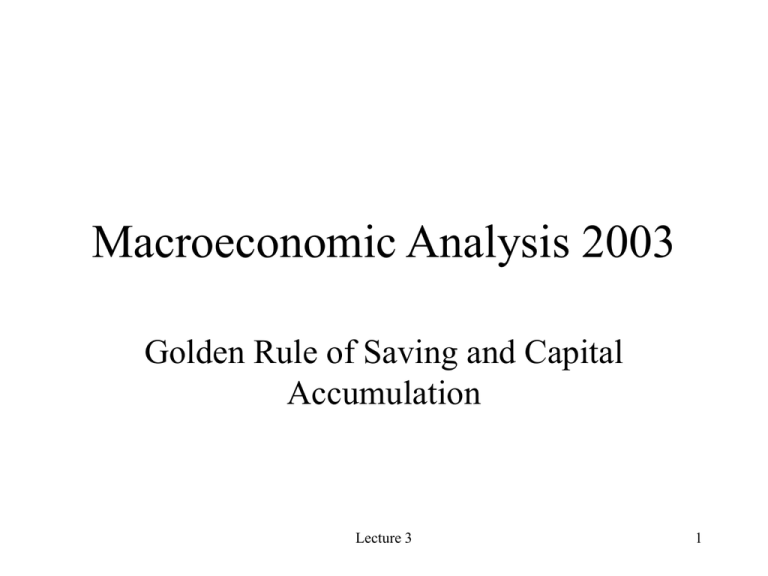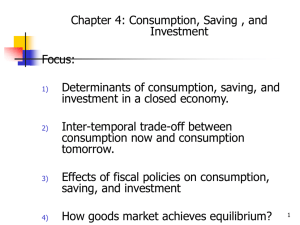Talk: Golden Rule
advertisement

Macroeconomic Analysis 2003 Golden Rule of Saving and Capital Accumulation Lecture 3 1 Saving and Investment Ratios Across the World 1984 60.00 40.00 Series1 SI Global I/Y = 0.5966(S/Y) - 5.9608 R2 = 0.1297 Saving Ratio 20.00 0.00 0.00 10.00 20.00 30.00 40.00 50.00 60.00 -20.00 -40.00 -60.00 Investment ratio Lecture 3 2 How does a higher saving rate affect the level of output in the steady state? y k 2 2 y2 y1 S sy sk 2 2 2 i n k 2 2 High saving country S sy sk 1 1 Low saving country Saving rate affects level of income but not the growth rates k2 k1 Lecture 3 k K L 3 How does the technological advancement affect the per capita capital and per capita output in the steady state? y k 2 2 y2 Advanced Technology i n k 2 2 S sy sk 2 2 2 Primitive Technology y k 1 1 y1 S sy sk 1 1 k2 k1 Lecture 3 k K L 4 Golden Rule for Saving and Capital Accumulation y k y Y L MPK n i n k k 1 n C-max S sy sk Kg Lecture 3 Kss k K L 5 Golden Rule of Saving What is the saving rate that maximises consumption? c y i c y n k Max c y n k c k 1 n 0 dk k 1 n MPK n (1) (2) (3) (4) (5) (6) Purpose of all economic activities is consumption. The capital stock where the slope of production function (marginal product of capital) equals the slope of the investment requirement line (depreciation plus the growth rate of the population) as given in (6). Lecture 3 6 A Numerical Example for the Golden Rule of Saving Take 11 different saving rates, s = 0, 0.1, 0.2, ……., 1.0. And capital stock like : 1, 4, 9, 16, 25, 36, 49, 64, 81 Y 0 .5 K L Assume in per capita terms y 0.05 , 0.5 , A=0.5 0.5k 0.5 Then calculate consumption, mpk and mpk –d as following s-rate 0.1 0.2 0.3 0.4 0.5 0.6 0.7 0.8 0.9 k 1.00 4.00 9.00 16.00 25.00 36.00 49.00 64.00 81.00 y 0.50 1.00 1.50 2.00 2.50 3.00 3.50 4.00 4.50 dk 0.05 0.2 0.45 0.8 1.25 1.8 2.45 3.2 4.05 c Saving s 0.45 0.8 1.05 1.2 1.25 1.2 1.05 0.8 0.45 0.05 0.2 0.45 0.8 1.25 1.8 2.45 3.2 4.05 mpk mpk-d 0.2500 0.1250 0.0833 0.0625 0.0500 0.0417 0.0357 0.0313 0.0278 0.2000 0.0750 0.0333 0.0125 0.0000 -0.0083 -0.0143 -0.0188 -0.0222 For this parametric configuration 50 percent saving rate maximises consumption. Lecture 3 7 How High Should be the Saving Rate? Saving Rate that Maximises Consumption C-max = 1.25 y = 0.5*k0.5 y=2.5 k = 25 s1 s2 s*=1.25 Lecture 3 s4 s5 Saving rate 8 Lecture 3 ly Lu Jap xe a m n b Ne o u rg th Ne erla nd w Ze s al an No d rw Po a y rtu ga l Sp a S w in Sw ed Un itz en ite er l a d Ki nd Un ng ite d om d St at es Ita lia Au st r B e ia lg iu m Ca na De da nm ar Fi k nl an Fr d an c G er e m an G y re ec Ic e el an d Ire la nd Au st ra Investment Ratio in OECD Countries:Average 1980-2000 35.00 30.00 25.00 20.00 15.00 10.00 5.00 0.00 9 0.00 Netherlands Luxembourg Japan 10 United States United Kingdom Switzerland Sweden Spain Portugal Norway New Zealand Lecture 3 Italy Ireland Iceland Greece Germany France Finland Denmark Canada Belgium Austria Australia Variation in the Saving Ratio Across OECD Countries: Average 1980-2000 35.00 30.00 25.00 20.00 15.00 10.00 5.00 Average Saving Rate in Growth Disaster Countries (1980-2000) 10.00 Series1 5.00 Za m bi a Se ne ga Si l er ra Le on Ve e ne zu el a, RB Ni ge r Ha iti G ha na M ad ag as ca r Ni ca ra gu a -5.00 Ch ad CA FR 0.00 -10.00 -15.00 -20.00 Lecture 3 11 Investment Ration in Growth Miracle Countries: Average 1980-2000 45.00 40.00 35.00 30.00 25.00 20.00 15.00 10.00 5.00 0.00 China Hong Kong, China Ireland Korea, Rep. Japan Lecture 3 Malta Portugal Singapore Thailand 12 Lecture 3 13 Lecture 3 14 Optimal Saving and Consumption in Two Period Model Intertemporal budget constraint: w2 C2 100 w1 C1 100 195.23 1 r 1 r 1.05 Optimal consumptions 195.23 C1 100.11 1 1.95 C 2 C1 1 r 1 r 0.95100.121.05) 99.86 1 If the interest rate is 10 percent 100 100 190.9 1.1 190.9 C1 97.9 1 C2 C1 1 r 0.9597.91.1) 102.3 Lecture 3 15 A Three Period Optimal Consumption-Saving Model Max U C , C , C ln C ln C ln C 1 2 2 3 3 1 2 3 Subject to: C W C W 1. C 2 3 W 2 3 1 1 r 1 1 r 2 1 r 1 r 2 2. ( W , W , W ) = (120, 1200, -120) 3. (C 0, C 0, C 0) 1 1 2 3 2 3 What is the optimal consumption in each period C ( 1 , C2 , C ) if 1 and r r 0 ? 3 1 2 1 2 Lecture 3 16 Four Optimisation Conditions L C ,C ,C , 1 2 3 C C 3 F 2 ln C ln C ln C C 1 2 2 3 3 1 1 r 1 r 2 our first order conditions: (1) L 1 0 1 C C C 1 1 1 L 2 0 1 (2) 2 C C 1 r C C 1 r 1 2 2 1 C 2 1 r C C 1 r 2 C 2 1 2 1 1 L 3 0 3 (3) C 2 C C 2 3 C11 r 1 3 1 r 1 C 2 3 1 r 2 C C 1 r 3 C 3 1 3 1 (4) L C C2 C3 0 1 1 r 1 r 2 C1 2C1 3C1 Lecture 3 17 Consumption and Savings in Three Periods Optimal Consumption in period 1: C 1 1 2 3 ; 1 r 2 Optimal Consumption in period 2: C C 1 r 2 1 2 1 2 3 2 r 1 2 3 Optimal Consumption in period 3: C C 1 r 3 1 3 1 2 3 S W C 120 400 280 1 1 1 Optimal saving in period 2: S W C 1200 400 2 2 2 Optimal saving in period 3: S W C 120 400 3 3 3 Optimal saving in period 1: Lecture 3 18 Policy Issues: Tax, Saving and Consumption • What is the impact in consumption and saving in the above model – If there is a 20 percent tax on interest income? – If there is a 20 percent subsidy in it? – What sort of tax system is better for increasing the ratio of saving? Does a higher rate of VAT promote saving or consumption? – Does a higher rate of tax on labour income encourage or discourage saving? – Does a higher rate of tax on pension income increase saving or consumption? Lecture 3 19 Which sectors are hit hard when the labour income is taxed more heavily than the capital income? Factor Shares Across Production Sectors in the UK (ONS) 1.00 0.90 Labour share Capital share 0.80 0.60 0.50 0.40 0.30 0.20 0.10 in d in g an Ag ric ul tu re tri q ua ci ty rry M ,g a in as nu g fa an ct d ur w in at g er W su ho pp C le o ly an al ns e t sp ru an or ct d io ta re n nd ta il co tra m de m Fi un na ic at nc Pu io ia n tio ls bl ic er n, vi ad he ce m al s in th i s an tra d tio so n ci al O w th or er k Se rv ic es - M Share 0.70 Do workers in the Service sector lobby for Higher capital income tax? Lecture 3 20 Which Sectors are important for a higher economic growth in the Yorkshire and Humberside region? (annual growth rates) Agri Mining Manf EGW Constr Distrib Transp Fin.Se Pub.A Ed/hea Other Total Maxgr Mingr uc ution ort rv dm. lth GDP wth wth 1983 -0.065 -0.130 0.056 0.124 0.129 0.104 0.091 0.136 0.144 0.072 0.058 0.072 0.144 -0.130 1984 0.336 -0.734 0.071 -0.181 0.105 0.126 0.160 0.106 0.111 0.126 0.052 0.040 0.336 -0.734 1985 -0.086 2.451 0.100 0.091 0.027 0.100 0.056 0.131 0.055 0.100 0.075 0.125 2.451 -0.086 1986 0.056 -0.029 0.128 0.053 0.048 0.120 0.089 0.170 0.053 0.122 0.146 0.109 0.170 -0.029 1987 0.033 -0.103 0.096 -0.003 0.226 0.082 0.082 0.052 0.058 0.096 0.113 0.077 0.226 -0.103 1988 -0.027 -0.116 0.104 -0.023 0.222 0.132 0.107 0.072 0.094 0.158 0.124 0.100 0.222 -0.116 1989 0.162 -0.030 0.097 -0.019 0.198 0.109 0.099 0.171 0.055 0.180 -0.081 0.113 0.198 -0.081 1990 0.100 -0.098 0.036 0.013 0.065 0.099 0.081 0.163 0.089 0.124 0.110 0.083 0.163 -0.098 1991 -0.014 0.116 -0.034 0.309 -0.088 0.079 0.056 0.046 0.044 0.145 -0.035 0.036 0.309 -0.088 1992 0.063 0.010 0.012 -0.044 -0.079 0.010 0.008 0.106 0.092 0.121 0.084 0.041 0.121 -0.079 1993 0.064 -0.265 0.057 -0.052 0.059 0.018 0.122 0.056 0.035 0.055 -0.005 0.043 0.122 -0.265 1994 -0.027 -0.412 0.041 -0.018 0.068 0.091 0.052 0.137 0.010 0.073 0.041 0.061 0.137 -0.412 1995 0.250 0.132 0.062 -0.080 0.007 0.092 0.072 0.062 0.038 0.041 0.102 0.061 0.250 -0.080 0.094 -0.013 0.027 0.044 0.017 0.004 0.060 0.027 0.101 -0.013 1996P 0.021 0.101 0.036 -0.003 Source: www.statistics.gov.uk Lecture 3 21 Why is the Manufacturing Sector So Important for Economic Growth? Sectoral compositon of Imports in UK and EU 0.8 0.7 1 EU 2 UK 0.6 0.5 0.4 0.3 0.2 0.1 El ec tri cit 5 y C on st ru ct io n 6 D ist rib ut io n 7 Tr an sp or t 8 Fi nS er v 9 Ed uc at io n 10 O th er 4 nf cs M 3 M 2 1 Ag ri in in ng 0 Lecture 3 22 Sectoral Composition of Exports in the UK and the EU 0.8 0.7 0.6 1 EU 2 UK 0.5 0.4 0.3 0.2 0.1 r th e O 10 Ed uc at Fi n 8 io n rt Se rv 9 7 Tr a ut rib 6 D is t ns po io n n tru ct io ci ty 5 C on s El ec tri cs 4 M nf 3 ng M in in 2 1 Ag ri 0 Lecture 3 23 Exercises • Calculate the saving rate consistent with the golden rule • Study of Relative income levels across regions in the UK • Study of economic growth in Hulls and Humberside • Which are the leading sectors of Economic Growth in the UK and in the Yorkshire and Humberside? Lecture 3 24




